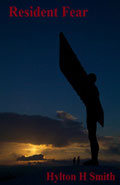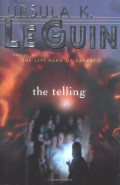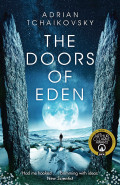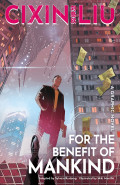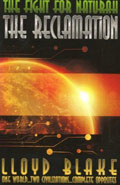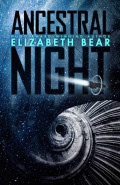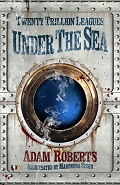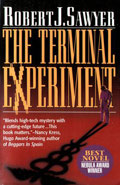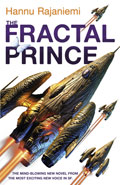Creation Machine
By Andrew Bannister

- Creation Machine
-
Author: Andrew Bannister
-
Publisher: Random House
- ISBN: 978-0593076484
- Published: May 2016
- Pages: 336
- Format reviewed: Paperback
- Review date: 25/05/2016
- Language: English
- Age Range: N/A
I’m always guilty of making snap judgements of books and their covers. Sci-fi covers don’t tend to help. Andrew Bannister’s The Creation Machine is not going to draw you in with its generic spaceship framed by a generic planet, and the woefully reductive, sensationalist logline of ‘It helped create a galaxy, now it might destroy one.’
Such a good debut really deserves better.
The far future tale is one of redemption, of the futility of rebelling against the system, and the nature of power. It’s told through two main perspectives: Fleare is an (ex) soldier of the anti-establishment Society Other, and the heavily augmented scion of a corporation forming that establishment.
Alameche is the second, the devious, despicable right hand man to The Patriarch, the overambitious dictator of a upstart inner system empire named The People’s Democratic Republic of Taussich. Alameche isn’t even an anti-hero, and by all accounts should be utterly unlikeable. However Bannister somehow infuses him with enough pathos and gallows humour to make his chapters some of the most gripping. Imaginative torture and Machiavellian scheming are Alameche’s modus operandi as he attempts to negotiate the complex power-play of the increasingly ambitious Patriarch.
Fleare enjoys the company of a motley band of supporting characters that definitely stand on their own merits too. Without giving too much away, one of the highlights of the novel is her relationship with Muz, who is introduced very enigmatically as a borderline psychotic collection of floating nanobots. Obviously there’s more to it, and him, and the drip feed of information on his and Fleare’s origin story, told through a number of flashback sequences, is wonderfully, tragically original. The same is true for Alameche’s associates, the rotund, jocular, giant-fighting-eel breeder Garamande in particular being a highlight and a wonderful counterpoint to Alameche’s savage puritanism.
Both his and Fleare’s perspectives orbit an ancient macguffin that has some kind of connection to the creation of The Spin, which means it likely has the power to destroy it too. The central conceit is interesting enough but it’s the issue that spawn from it - the power struggle on Taussich, Fleare’s tracking down of her old buddies, and more - that really propel the action and pages forward. The chronology leaps around too, with flashback chapters dealing with the two main characters’ turbulent pasts and filling in the context behind the forces flexing their wings in the Spin. As with any good space opera there are plenty of nebulous and intersectional politics in play, but The Creation Machine is really a very personal story, the characters flirting with events that influence the macrocosm.
Although it has no voice, the aforementioned Spin is a brilliant character in its own right. The enigmatic, man-made galaxy is a fascinating setting, full of improbable but plausible phenomena, such as a mess of elaborate orbits described as showing their creators sense of humour. The innermost group of planets is The Cordern, then the Inner Spin ‘which wrapped most of the way round the Cordern like a thick skin’. Up against the exposed side of the spin is the Rotate, and encircling the whole lot is the Outer Spin. The system is filled with inventive details like the Highway, a star-lane that intersects it all when the elaborate orbits occasionally slot into place, and the Catastrophe Curve, formed when two planets collided and ‘competing gravity fields smeared the debris out over an arched tendril half a million kilometres long’. Bannister orients the reader briefly at the beginning of each chapter, with evocative, brief descriptions of the current setting’s improbable features, leaving plenty to the imagination without distracting from the following action.
Towards the end of the book, things also take a rather cyberpunk twist which adds a pleasantly unexpected layer. Initially it’s a jarring change of pace, but the way the character known as Rudi and his ‘world’ becomes reintegrated into the grander scheme of things is a fascinating tie up. His sections do however feel slightly underdeveloped, as though Bannister didn’t quite have the time or confidence to let his exploits truly blossom, but they’re welcome segments and give a tantalising look at the possible breadth to Bannister’s new universe, and his writing.
By focusing on some very specific elements such as the mechanics of the Spin and blending in some cyberpunk influences, the novel carves enough space for itself in an increasingly self-referential genre. There are small lore and background gaps in The Creation Machine that does not overly detract but will need to be address in the apparently stand-alone sequel. With the creation of the Spin, Taussich’s proto-empire and the position it finds itself in at the close of the book, the stage is set for an incendiary follow up, so it’ll be interesting to see if a sequel that doesn’t follow on directly can capitalise on that. Either way, there’s enough great action, surprisingly morbid humour and great characters to make The Creation Machine an enjoyable and accessible ‘soft’ sci-fi cum space opera.
Written on 25th May 2016 by Danny.
